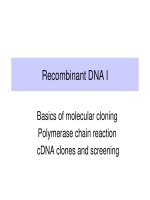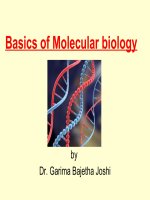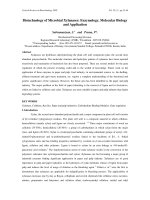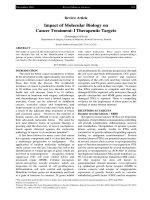Basics of molecular biology
Bạn đang xem bản rút gọn của tài liệu. Xem và tải ngay bản đầy đủ của tài liệu tại đây (1.04 MB, 69 trang )
Basics of Molecular biology
by
Dr. Garima Bajetha Joshi
Basic differences between eukaryotes and
prokaryotes
Attribute
Eukaryotes
Prokaryotes
Organisms
Plants, animals and fungi
bacteria and cyanobacteria
Cell wall
No (animals); Yes (plants)
yes
Chromosome
segregation
Mitotic spindle
Cell membrane
meiosis
+
_
Ribosome size
80 s
70 s
Nuclear membrane
+
Absent
Endoplasmic
reticulum
+
-
Golgi apparatus
+
-
Mitochondria
+
-
Chloroplast
+
-
Cell organelle
Molecular biology: definition
• Molecular biology is the study of molecular underpinnings of
the process of replication, transcription and translation of the
genetic material.
•
This field overlaps with other areas of biology and chemistry,
particularly genetics and biochemistry. Molecular biology chiefly
concerns itself with understanding the interactions between the
various systems of a cell, including the interactions between DNA,
RNA and protein biosynthesis as well as learning how these
interactions are regulated.
•
Much of the work in molecular biology is quantitative, and recently
much work has been done at the interface of molecular biology and
computer science in bioinformatics and computational biology.
•
Since the late 1950s and early 1960s, molecular biologists have
learned to characterize, isolate, and manipulate the molecular
components of cells and organisms includes DNA, the repository of
genetic information; RNA, a close relative of DNA; and proteins, the
major structural and enzymatic type of molecule in cells.
Components involve in molecular
biology
DNA
RNA
Protein
Gene : Unit of heredity
• The DNA segments that
carries genetic information are
called genes.
• It is normally a stretch of DNA
that codes for a type of protein
or for an RNA chain that has a
function in the organism.
• Genes hold the information to
build and maintain an
organism's cells and pass
genetic traits to offspring.
Deoxyribonucleic acid (DNA)
• DNA is a nucleic acid that contains the genetic
instructions used in the development and functioning of
all known living organisms and some viruses.
• DNA is a set of blueprints needed to construct other
components of cells, such as proteins and RNA
molecules.
• Two long strands makes
the shape of a double helix.
• two strands run in opposite
directions to each other and
are therefore anti-parallel.
• Chemically, DNA consists
of two long polymers of
simple
units
called
nucleotides,
with
backbones made of base,
sugars
and
phosphate
groups.
Fig : DNA double helix
Sugar +Base = nucleoside
nucleoside
Phosphate+ sugar + Base = nucleotide
Bases
• Types:- adenine and guanine (fused five- and sixmembered heterocyclic compounds) – Purines
• cytosine & thymine (six-membered rings)-Pyrimidines.
• A fifth pyrimidine base, called uracil (U), usually takes
the place of thymine in RNA and differs from thymine by
lacking a methyl group on its ring.
• PAIRING : A =T and A=U
G≡C
•
The DNA double helix is stabilized by hydrogen bonds between the
bases attached to the two strands.
•
One major difference between DNA and RNA is the sugar, with the
2-deoxyribose in DNA being replaced by the alternative pentose
sugar ribose in RNA.
Ribose
Size:
• The DNA chain is 22 to 26 Ångstrưms wide (2.2 to
2.6 nanometres), and one nucleotide unit is 3.3 Å
(0.33 nm) long.
Ribonucleic acid (RNA)
•
•
RNA is a biologically important type of molecule that consists of a
long chain of nucleotide units.
Each nucleotide consists of a nitrogenous base, a ribose sugar,
and a phosphate.
Double-stranded RNA
• Double-stranded RNA
(dsRNA) is RNA with two
complementary strands,
similar to the DNA found in all
cells.
• dsRNA forms the genetic
material of some viruses
(double-stranded RNA
viruses).
Types of RNA
Type
Abbr
mRNA
Function
Codes for protein
Distribution
All organisms
Ribosomal RNA
rRNA
Translation
All organisms
Transfer RNA
tRNA
Translation
All organisms
Messenger RNA
in post-transcriptional modification
Small nuclear RNA
snRNA
Y RNA
Telomerase RNA
Splicing and other
Eukaryotes and
functions
archaea
RNA processing, DNA
Animals
replication
Telomere synthesis
Most eukaryotes
Regulatory RNAs
Antisense RNA
aRNA
Transcriptional attenuation /
mRNA degradation / mRNA
All organisms
stabilisation / Translation block
Messenger RNA
• mRNA carries information about a protein sequence to the
ribosomes, the protein synthesis factories in the cell.
• It is coded so that every three nucleotides (a codon)
correspond to one amino acid.
• In eukaryotic cells, once precursor mRNA (pre-mRNA) has
been transcribed from DNA, it is processed to mature
mRNA. This removes its introns—non-coding sections of the
pre-mRNA.
• The mRNA is then exported from the
nucleus to the cytoplasm, where it is
bound to ribosomes and translated into its
corresponding protein form with the help
of tRNA.
• In prokaryotic cells, which do not have
nucleus and cytoplasm compartments,
mRNA can bind to ribosomes while it is
being transcribed from DNA.
Transfer RNA
• Transfer RNA (tRNA) is a small RNA chain of about 80
nucleotides that transfers a specific amino acid to a
growing polypeptide chain at the ribosomal site of protein
synthesis during translation.
•
It has sites for amino acid attachment and an anticodon
region for codon recognition
• that site binds to a specific sequence on the messenger
RNA chain through hydrogen bonding.
Ribosomal RNA
•
•
•
•
•
•
Ribosomal RNA (rRNA) is the catalytic
component of the ribosomes.
Eukaryotic ribosomes contain four different
rRNA molecules: 18S, 5.8S, 28S and 5S
rRNA.
rRNA molecules are synthesized in the
nucleolus.
In the cytoplasm, ribosomal RNA and
protein combine to form a nucleoprotein
called a ribosome.
The ribosome binds mRNA and carries out
protein synthesis. Several ribosomes may
be attached to a single mRNA at any time.
rRNA is extremely abundant and makes
up 80% of the 10 mg/ml RNA found in a
typical eukaryotic cytoplasm.
Difference between RNA & DNA
RNA
DNA
RNA nucleotides contain
ribose sugar
DNA contains deoxyribose
RNA has the base uracil
DNA has the base thymine
presence of a hydroxyl
group at the 2' position of
the ribose sugar.
Lacks of a hydroxyl group at
the 2' position of the ribose
sugar.
RNA is usually singlestranded
DNA is usually doublestranded
Protein
• Proteins (also known as polypeptides)
are made of amino acids arranged in a
linear chain and folded into a globular
form.
• The sequence of amino acids in a protein
is defined by the sequence of a gene,
which is encoded in the genetic code.
• genetic code specifies 20 standard amino
acids.
Basic players in molecular biology: DNA, RNA, and
proteins. What they do is this :
DNA replication
• DNA replication, the basis for biological inheritance, is a
fundamental process occurring in all living organisms to
copy their DNA.
• In the process of "replication" each strand of the original
double-stranded DNA molecule serves as template for the
reproduction of the complementary strand.
• Two identical DNA molecules have been produced from a
single double-stranded DNA molecule.
•
•
•
•
In a cell, DNA replication begins at specific locations in the genome,
called "origins".
Unwinding of DNA at the origin, and synthesis of new strands,
forms a replication fork.
In addition to DNA polymerase, the enzyme that synthesizes the
new DNA by adding nucleotides matched to the template strand, a
number of other proteins are associated with the fork and assist in
the initiation and continuation of DNA synthesis.
Cellular proofreading that ensure near perfect fidelity for DNA
replication.









